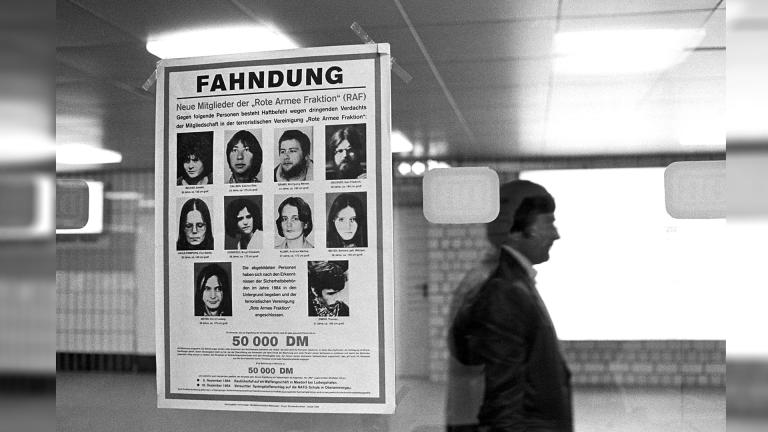
Read more about Modern History

Have you ever heard of the Baader-Meinhof gang? Also known as the Red Faction Army (RAF, though not to be confused with the Royal Air Force of the UK), this left-wing militant group terrorised West Germany for more than a dozen years in the 1970s and 80s.
Railing against the perceived ineffectiveness of West Germany’s attempts to denazify itself, and against the encroaching creep of consumerist America, the group kidnapped and assassinated major figures from industry and economy, as well as detonating bombs in public places, too.
Join us at Sky HISTORY as we explain everything you need to know about this extreme and explosive chapter in left-wing German politics.
After WWII, many high-profile Nazis managed to escape prosecution, leading to widespread unrest in the country and especially among the student population. In 1968, one particular radical student named Andreas Baader took matters into his own hands by detonating two homemade explosives in department stores in Frankfurt to launch a campaign of violent protest.
The campaign appeared to have stalled when Baader was arrested and imprisoned. However, a cunning plot to engineer his escape was soon put into motion when left-wing journalist Ulrike Meinhof managed to secure permission to interview him in the library prison.
Accompanied by two female assistants who were concealing firearms in their handbags, Meinhof quickly overpowered the guards and the quartet escaped through a window. The Baader-Meinhof gang was born.
After receiving weapons and explosives training from the Palestinian Liberation Organisation (PLO) in Jordan, the founding members of the RAF returned to West Germany and relaunched their campaign.
Chief among their targets were the state, the USA and NATO. They robbed numerous banks, then used the funds to attack media headquarters and military sites. Eventually, both Baader and Meinhof were apprehended by the authorities in 1972, the same year that West Germany suffered yet more trauma at its disastrous Olympic Games.
In retaliation, other members of the RAF launched a concerted programme of carjackings, kidnappings and murders of high-profile members of the German establishment, which came to a head between July and October 1977. This period would come to be known as the 'German Autumn'.
Among others, they bungled the kidnapping of the head of Dresdner Bank Jurgen Ponto, killing him instead, as well as successfully abducting Hanns Martin Scheyler, a former SS officer who had continued to prosper. When their demands to release the imprisoned leaders of the RAF were ignored, they executed Scheyler.
Meanwhile, two plane hijackings also resulted in the RAF’s demands not being met, with the perpetrators killed by special forces units on both occasions. Shortly afterwards, Baader committed suicide, with Meinhof already having done so prior to the commencement of the German Autumn.
While the height of RAF activity had come to a close, the organisation continued to carry out attacks all through the 1970s, 1980s and part of the 1990s. The first generation of members is defined as Baader, Meinhof and others who had been there from the outset.
The second generation of RAF militants focused mostly on trying to free the first. But while the group had initially enjoyed much support among the West German youth for taking a stand against an inability or unwillingness to bring Nazis and Nazi collaborators to justice, their increasingly violent tactics saw this dwindle.
By the time the third generation rolled around (roughly defined as 1982 to 1998), the group had lost its structure and direction. The fall of the Berlin Wall meant that their purpose had become confused, with a scattergun attempt to eliminate elite figures enjoying little approval among the wider populace.
In 1998, the Baader-Meinhof group sent an anonymous letter to Reuters declaring that 'the urban guerrilla group in the form of the RAF is now history'. Many of their members had still not been apprehended and were forced to live the remainder of their lives in hiding.
As recently as 2016, German authorities renewed attempts to track down some of its more notorious members, including Daniela Klette, who at the time was the only woman on Europol’s wanted list described as 'dangerous'. In 2024, Klette was finally arrested, though other members of the group remain at large.
The name of the group itself has, in recent years, perhaps become more famous than its exploits. In 1994, a man named Terry Mullen penned a letter to the prominent Minnesota newspaper St Paul Pioneer Press. In it, he explained that he had recently read an article about the RAF, then found himself coming across their name everywhere in the days following.
Mullen himself coined the term 'Baader-Meinhof phenomenon' for a frequency illusion which suggested that within 24 hours of learning an obscure name or fact, it would crop up in print, media or person again. So now that you’ve learned about the RAF, keep your eyes peeled this week for them to surface in your life again!
For timely news about future historical documentaries, sign up to the Sky HISTORY Newsletter.